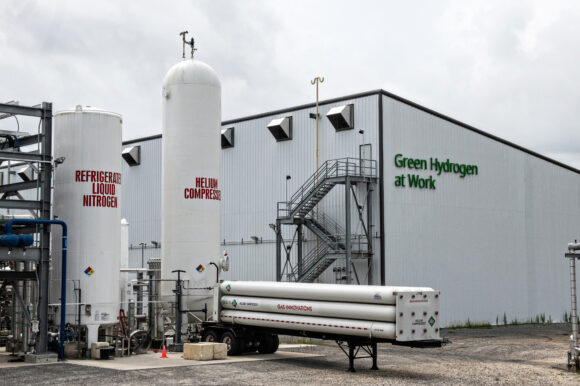Despite federal policy uncertainty stunting growth prospects, US clean hydrogen industry leaders at the BloombergNEF summit see one bright spot: Texas.
President Donald Trump’s tariffs are impacting the industry as are the murky fate of federal tax credits and the $7 billion hydrogen hub program. Those incentives are seen as critical to green hydrogen producers.
Unsubsidized, the average cost to produce the gas using renewable electricity and water is about $8 to $9 per kilogram, according to BloombergNEF. That’s about four times higher than using fossil fuels. BNEF hydrogen analyst Payal Kaur said more federal funding is needed to make clean hydrogen cost competitive, though “we’re probably not going to get more support from this new administration.”
But the heads of major industry players see an opportunity to bring down production costs for the clean fuel by tapping cheap renewable energy in Texas.
Green hydrogen producer and equipment maker Plug Power Inc. is among the companies planning to build in the state. The company has a liquid hydrogen production facility in the works a few hours west of Dallas that it says will create hundreds of jobs.
“Politics are local, and people care about jobs,” said Chief Executive Officer Andy Marsh. He called the characterization of the US green hydrogen industry as dead “not fair.”
When complete, Plug’s Texas facility will produce 45 tons of hydrogen per day, doubling the company’s current capacity. The plant, powered by an adjacent wind farm, will be funded in part by a $1.66 billion loan guarantee from the Energy Department’s Loan Programs Office.
Electrolyzer maker Verdagy Inc. is also building a clean hydrogen plant near the Gulf Coast in Texas, which will initially be able to produce 9,000 tons per year, according to President Rahul Bammi. The company has already secured offtake agreements.
Pairing electrolyzers powered by cheap, renewable energy and running them nearly around the clockmakes it possible to bring costs down, said Bammi. Verdagy will run its Texas plant at 80% capacity, and the company is simulating that plant in California today.
“We know we can get that 80%. It’s not a theoretical construct,” Bammi said. That’s helping Verdagy bring green hydrogen costs down to $3 per kilogram, and Bammi projected the company could get costs down to $2 per kilogram in two to three years
That price is far below BNEF’s estimates released late last year of the global cost of green hydrogen, which ranges from $3.74 to $11.70 per kilogram. The group found hydrogen produced in Texas will be among the cheapest in the US, though it projects that the per-kilogram cost in 2030 will be $4.82.
Topics Texas
Was this article valuable?
Here are more articles you may enjoy.



 Twice Injured Firefighter Loses Second Workers’ Compensation Claim
Twice Injured Firefighter Loses Second Workers’ Compensation Claim  Head of EEOC Urges White Men to Report Discrimination
Head of EEOC Urges White Men to Report Discrimination  Aon Adds to List of Brokers Suing Howden US for Alleged Poaching, Theft
Aon Adds to List of Brokers Suing Howden US for Alleged Poaching, Theft  Court Ruling Could Help Shed Light on Owners of Litigation Funders, Medical Clinics
Court Ruling Could Help Shed Light on Owners of Litigation Funders, Medical Clinics 

